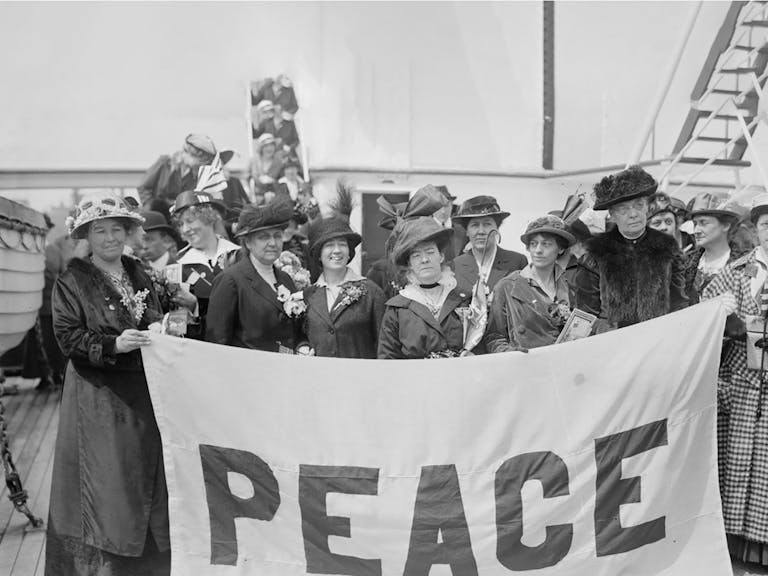
“Women are part of those who think and build the world of the future”
As a historian, I researched how studying the future, during the cold war, was a way to bring forward new issues, new ideas and new fights. My PhD work focused on how and why studies about the future of the world were conducted.
I found out that between the early sixties and the end of the eighties, a loose network of scholars, activists and international civil servants worked to build an expertise about the tools that could be used to explore the possible futures of the world and raised awareness about the notion of world problems
.
From peace studies to global future studies
Their studies about the future revolved around big issues that seemed important for the future of the world. They put the emphasis on the idea that no nation or company could solve the most important problems of the future alone and they insisted, on the contrary, on the fact that discussing those long-term issues could help international cooperation.
This history of international futures studies began with peace activists and the issue of atomic disarmament at the beginning of the sixties. People like the Dutch Fred Polak and institutions like the International Confederation for Disarmament and Peace insisted on the need to create positive images of disarmed futures.
The scenarios they created often included a reflection about how the resources that would be freed by disarmament could be used to help development in newly decolonized countries. With this connection established between peace and development, peace activists took a broader interest in the future and joined larger networks of people interested in studying the future.
Studying globalized futures to better build a shared future
During the 70s, this interest for global futures led to an institutionalization of futurology. The Unesco created its first foresight program in the early 70s. It stopped in 1974 but the same year, a Project on the future
was created at Unitar, an international institute which was then regarded as the United Nations' think tank.
The idea that the future had to be studied and discussed at an international level gained momentum, but it became clear that conflicting visions for this global future coexisted and that creating scenarios or models about the future was a way to express one's values and preferences for this shared future.
The 80s were a moment of triumph for international futurology: foresight programs were more and more numerous in international organizations. But the 80s were also marked by the end of the ambition to create a unified field of studies about the future of the world as more and more people started doing foresight studies in addition to their regular activity. Soon, regional studies and thematic studies replaced global futurology projects.
The future is also feminine
Since this is a women edition, let's now focus on the role women played in this history of international futures studies. Several women were in fact key players. The first international pacifist association to take an interest in future studies was an all-women's association: the Women International League for Peace and Freedom.
As early as 1962, this association organized conferences in which activists explained that building positive images of a disarmed future was a better way of convincing public opinion and decision-makers than stirring up fears of a nuclear future.
A decade later, it was another woman, Graciela Chichilnisky, who had a profound influence on the direction the UNITAR project on the future was taking. An Argentinian mathematician and economist, she was working on the creation of global resources management models that optimized their distribution so that the countries of the South can develop while respecting the environment.
In this context, she insisted on the notion of basic needs
, and on the need to prioritize the satisfaction of these basic needs by all individuals, rather than maximizing the global GDP of each country.
Women have thus played a key role in shaping thinking about the world's future. But they have also been thinking more specifically about the place women should hold in this new field of expertise, and about the ways in which the future world could offer a better balance between men and women.
Strengthening women's active participation in shaping a common future
On this subject, it is important to mention the work of Elise Boulding. This American sociologist played a key role in the peace movements of the 1960s and in international networks of future experts. She also helped launch the first women's studies programs in the 1970s.
Her work insisted on the idea that, while women are in essence no different from men, they have historically had, and still have, a different experience from them, and are required to develop skills that men often lack, particularly in the field of peacebuilding. It is therefore crucial for Elise Boulding that women are part of those who think and build the world of the future. The aim is that, for a transitional period, women can give men the benefit of their skills, and vice versa. Men and women could then all receive an education incorporating the best of both worlds and work together to make the world a more peaceful, environmentally-friendly and just place.
Elise Boulding's discourse placed great emphasis on what women have to contribute to the future, but it was also feminist in the sense that the future world women would help create would offer them a better place, and greater responsibilities, equal to those of men.
If she were still with us, she would probably be surprised and delighted to see the composition of this meeting dedicated to the prospective female perspective
As a conclusion, I love the future because it is both deeply connected to the past and open to various possible paths. Studying its history is fascinating and allows us to understand how imagining positive scenarios can contribute to making them happen by making those alternative futures thinkable and therefore actionable.